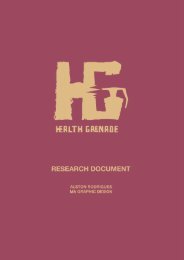ResearchDocument
Create successful ePaper yourself
Turn your PDF publications into a flip-book with our unique Google optimized e-Paper software.
From the research findings which included lunchtime audits, personal<br />
group talks etc., the AMP noticed that teenagers were very<br />
well aware of their unstable and unhealthy diets and was perceived<br />
as too big of a change to eat more healthier. They came up with a<br />
strategy which involved inspiring them, which involved showing how<br />
making small changes leads to big rewards that they will notice both<br />
immediately and in the future. (AMP Agency, 22 March 2013)<br />
Children’s book cover and stickers designs<br />
<br />
It was also important to educate parents and other family members<br />
about the importance of healthy eating for this to work. To do that,<br />
ALDI launched a website which supported the campaign and also<br />
attempts at educating them about it. Adding on to it all, ALDI has<br />
also come up with a number of larger cookbooks and lunch packs<br />
which are specifically designed for adults. (Tattershall, Louisse,<br />
2013)<br />
Graphic design has also found its way into a number of projects<br />
and campaigns as just a supporting factor to boost them. A case<br />
study was conducted by the AMP agency on the project “Change<br />
One Thing” which was for a client called Food Bank For New York<br />
City, which ran for an entire year from July-September 2011 to<br />
July-September 2012. Looking at the bank’s background, they are<br />
one of the United States’ largest food banks that aim at eradicating<br />
hunger by helping feed the poor throughout the city and by also<br />
providing nutrition related educational programs for around 40,000<br />
children and adults. This also includes a number of poor people<br />
that spreads up to 2.6 million people in just New York City itself.<br />
(AMP Agency, 22 March 2013)<br />
To counter this, the AMP Agency came up with a social strategic responsibility<br />
program that focused itself on educating the youth from<br />
low-income households in the states on healthy eating, mainly the<br />
ones from the five boroughs situated in New York city. Their target<br />
was to reach around a 100,000 teenagers all of who met a very<br />
strict criterion as defined by the USDA, who are also the funders of<br />
the campaign. (AMP Agency, 22 March 2013)<br />
To spread the word about the campaign, they used both traditional<br />
and non- traditional methods. One of them was the use of billboards,<br />
some of which showed off handmade adaptations of their<br />
ads, all of which were strategically placed all over the city in transit<br />
stations. Other methods also included spreading the word about<br />
the campaign on radio stations by setting up specialized promotions<br />
and also showed up at various local events along with the branded<br />
materials from the campaign. Amongst all the methods involved in<br />
the process of spreading the news, the use of a customized food<br />
truck, which gave out nutritious, healthy food during the summer<br />
and even featured an interactive game about healthy eating habits,<br />
was also considered. (AMP Agency, 22 March 2013)<br />
Looking at the designing bit of the campaign, a photo shoot was<br />
done with a man named Gary Sloan in his studio, showing many<br />
horrible looking snack foods along with the hero portrayed healthy<br />
foods. This was taken up to counter ads out there, which influenced<br />
children to make bad food choices on a daily basis. A number of<br />
techniques were used to show the fast foods as unappealing in<br />
nature by showing them sweat, melt and drip. The healthier food<br />
images were places strategically next to the unhealthy ones to<br />
emphasize their importance. The ads also used bright colors to add<br />
to make the good foods more prominent to catch people’s attention<br />
along with the use of clean and solid band of colors to bring out the<br />
headlines. (AMP Agency, 22 March 2013) To add on to the design<br />
involved, transit advertising and traditional billboards were used to<br />
advertise the campaign.<br />
The AMP agency also used various other strategies like spreading<br />
the word through radio stations by getting into a partnership with<br />
the stations, and the use of traditional methods like hand painted,<br />
neighborhood mural paintings. The food truck previously mentioned<br />
made its way all over the city to summer camps, teen centers,<br />
etc. Children were allowed to learn and play an interactive, creatively<br />
designed game, which taught them about the benefits and<br />
advantages of healthy food, bringing to light the consequences of<br />
consuming bad foods. The food truck also handed on free samples<br />
of frozen fruit pops, recipe books for teens, sliced apples etc. (AMP<br />
Agency, 22 March 2013)<br />
“Change One Thing” ran for an entire year and proved to be a success<br />
showing a significant change in the behavior of teenagers all<br />
over the city. A ten percent rise in the importance of healthy eating<br />
amongst low-income children was noticed. According to the case<br />
study, “<br />
Children playing an interactive health food game on the food truck<br />
they had changed their eating behaviors while the campaign was in<br />
market.<br />
fifty percent of the respondents stated that<br />
Sixty-eight percent of these respondents report that they are trying<br />
to make<br />
healthier eating decisions and 64 percent report that they are<br />
thinking more<br />
about how what they choose to eat will affect them in the future.”<br />
(AMP Agency,<br />
22 March 2013)<br />
56




